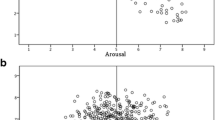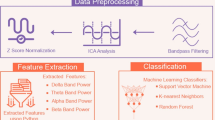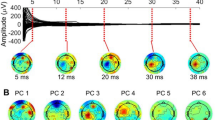Abstract
This paper discusses the challenges in achieving bio-signal-based design environments. While the main motivation of this paper was to provide a user interface for physically disabled people to express their artistic natures, a special emphasis is given on graphical user interface design where bio-signals are the single input source. Among three bio-signal sources investigated—electromyography, electrooculography and electroencephalography (EEG)—stimulus-based human–computer interaction design (EEG feature extraction method) is found to be the most promising for achieving design environments to perform complex tasks. In the proposed stimulus-based brain–computer-interaction application, the user communication with a computer is achieved by coupling intended functionalities with stimuli signals on the computer screen. Constant focus on the intended command stimulates the brain. In return, the brain releases a response signals (steady state visual evoked potential). In theory, brain’s response signals and the stimulus signals are identical. Once successfully identified, the presence of a signal pattern that is identical to the one of the alternative stimulus signals (paired with a command in a user interface) indicates the intention of a user. Since each option is associated with a unique signal pattern, multiple options can simultaneously be offered to users. The main challenge of working with stimulus signals is that the response signals are weak and they are buried inside of highly polluted EEG signals that include brain’s natural activities. In this paper, we introduce a signal processing algorithm based on Lorenz systems of differential equations for identifying the source of stimulus signals. Our experiments strongly suggest that bio-signal-based design environments to perform complex tasks, including geometric modeling can be achieved by utilizing stimulus-based signal processing methodology.







Similar content being viewed by others
References
Ahsan, R., Ibrahimy, M. I., & Khalifa, O. O. (2009). EMG signal classification for human computer interaction: A review. European Journal of Scientific Research, 33(3), 480–501.
Akdogan, E., Tacgin, E., & Adli, M. A. (2009). Knee rehabilitation using an intelligent robotic system. Journal of Intelligent Manufacturing, 20(2), 195–202.
Bin, G., Gao, X., Wang, Y., Hong, B., & Gao, S. (2009). VEB-based brain computer interfaces: Time, frequency, and code modulations. IEEE Computational Intelligence Magazine, 4(4), 22–26.
Bin, G., Gao, X., Yan, Z., Hong, B., & Gao, S. (2009). An online multi-channel SSVEP-based brain–computer interface using a canonical correlation analysis method. Journal of Neural Engineering, 6(4), 1–6.
Birx, D. L., & Pipenberg, S. J. (1992). Chaotic oscillators and complex mapping feed forward networks (CMFFNS) for signal detection in noisy environments. IEEE International Joint Conference on Neural Network, 2, 881–888.
Boostani, R., & Moradi, M. H. (2003). Evaluation of the forearm EMG signal features for the control of a prosthetic hand. Physiological Measurement, 24(2), 309–319.
Cecotti, H., Volosyak, I., & Graser, A. (2010). Reliable visual stimuli on lcd screens for ssvep based BCI. In The 2010 European signal processing conference (EUSIPCO-2010) Aalborg, Denmark.
Chen, L., & Wang, D. S. (2007). Detection of weak square wave signals based on the chaos suppression principle with non-resonant parametric drive. Acta Physica Sinica, 56(9), 5098–5102.
Cheng, M., Gao, X. R., Gao, S. K., & Xu, D. F. (2002). Design and implementation of a brain–computer interface with high transfer rates. IEEE Transaction on Biomedical Engineering, 49(10), 1181–1186.
Chouikhi, H., Khatab, A., & Rezg, N. (2014). A condition-based maintenance policy for a production system under excessive environmental degradation. Journal of Intelligent Manufacturing, 25(4), 727–737.
Crawford, B., Miller, K., Shenoy, P., & Rao, R. (2005) Real-time classification of electromyographic signals for robotic control. In Proceedings of AAAI (pp. 523–528)
Fariman, H. J., Ahmad, S. A., Marhaban, M. H., Ghasab, M. A. J., & Chappell, P. H. (2015). Simple and computational efficient classification approach for EMG-controlled prosthetic hand: ANFIS vs. artificial neural network. Intelligent Automation & Soft Computing, 21(4), 559–573.
Felzer, T., & Freisleben, B. (2002). Controlling a computer using signals originating from muscle contractions. In Proceeding of METMBS (Vol. 2, pp. 336–342).
Felzer, T., Nordmann, R., & Rinderknecht, S. (2009). Scanning-based human–computer interaction using intentional muscle contractions. In Lecture notes in computer science (Vol. 5615, pp. 509–518).
Freeman, W. J. (1987). Simulation of chaotic EEG patterns with a dynamic model of the olfactory system. Biological Cybernetics, 56(2–3), 139–150.
Freeman, W. J. (1988). Strange attractors that govern mammalian brain dynamics shown by trajectories of electroencephalography (EEG) potentials. IEEE Transactions on Circuits and Systems, 35(7), 781–784.
Gao, X., Xu, D., Cheng, M., & Gao, S. K. (2003). A BCI-based environment controller for the motion-disabled. IEEE Transaction on Neural Systems and Rehabilitation Engineering, 11(2), 137–140.
Jia, H., Gao, X. R., Hong, B., & Gao, S. K. (2011). Frequency and phased mixed coding in SSVEP-based brain–computer interface. IEEE Transaction on Biomedical Engineering, 55(1), 200–206.
Jin, J., Allison, B. Z., Sellers, E. W., Brunner, C., Horki, P., Wang, X., et al. (2011). Optimized stimulus presentation patterns for an event-related potential EEG-based brain–computer interface. Medical and Biological Engineering and Computing, 49(2), 181–191.
Kamrunnahar, M., Dias, N. S., & Schiff, S. J. (2009). Optimization of electrode channels in brain computer interface. In Proceedings of annual international conference of IEEE engineering in medicine and biology society.
Kluge, T., & Hartmann, M. (2007). Phase coherent detection of steady-state evoked potentials: Experimental results and application to brain–computer interfaces. In Proceeding of 3rd international IEEE EMBS neural engineering conference (pp. 425–429).
Li, C. H. S. (2005). Study of weak signal detection based on second FFT and chaotic oscillator. Nature and Science, 3(2), 59–64.
Liu, X., Fang, X., Qin, Z., Ye, C., & Xie, M. (2011). A short-term forecasting algorithm for network traffic based on chaos theory and SVM. Journal of Network System Management, 19, 427–447.
Lorenz, E. N. (1963). The mechanics of vacillation. Journal of Atmospheric Science, 20(5), 448–465.
Luo, A., & Sullivan, T. J. (2010). A user-friendly SSVEP-based brain–computer interface using a time-domain classifier. Journal of Neural Engineering, 7(2), 26010.
Muller-Puts, G. R., Scherer, R., Braueis, C., & Pfurtscheller, G. (2005). Steady-state visual evoked potential (SSVEP)-based communication: Impact of harmony frequency components. Journal of Neural Engineering, 2(4), 123–130.
Muller-Putz, G. R., & Pfurthscheller, G. (2008). Control of an electrical prosthesis with an SSVEP-based BCI. IEEE Transaction on Biomedical Engineering, 55(1), 361–364.
Nguyen, K. T., & Nguyen, T. T. (2011). Using electrooculogram and electromyogram for powered wheelchair. In International conference on robotics and biomimetic, Phuket, Thailand.
Rechy-Ramirez, E. J., & Hu, H. (2014). A flexible bio-signal based HMI for hands-free control of an electric powered wheelchair. International Journal of Artificial Life Research, 4(1), 59–76.
Ribeiro, A. P. R., Brasil, F. L., Witkowski, M., Shiman, F., Cipriani, C., Vitiello, N., et al. (2013). Controlling assistive machines in paralysis using brain waves and other biosignals. Advances in Human–Computer Interaction, 2013(3), 1–9.
Takano, Y., & Suzuki, K. (2014). Affective communication aid using wearable devices based on bio-signals. In IDC ’14 proceedings of the 2014 conference on interaction design and children, Aarhus, Denmark, pp. 213–216.
Torres, F., Jimenez, L. M., Candelas, F. A., Azorin, J. M., & Agullo, R. J. (2002). Automatic inspection for phase-shift reflection defects in aluminum web production. Journal of Intelligent Manufacturing, 13(3), 151–156.
Wang, G. Y., Chen, D. J., Lin, J. Y., & Chen, X. (1999). The application of chaotic oscillators to weak signal detection. IEEE Transactions on Industrial Electronics, 46(2), 440–444.
Wang, Y. J., Wang, R. P., Gao, X. R., Hong, B., & Gao, S. K. (2006). A practical VEP-based brain–computer interface. IEEE Transaction on Neural Systems and Rehabilitation Engineering, 14(2), 234–240.
Wang, Y. J., Zhang, Z. G., Gao, X. R., & Gao, S. K. (2004). Lead selection for SSVEP-based brain–computer interface. In Proceedings of the \(26^{th}\) annual international conference of the IEEE EMBS, San Francisco, pp. 4507–4510
Wei, L., Hu, H., & Yuan, K. (2008). Use of forehead bio-signals for controlling an intelligent wheelchair. In Proceedings of the 2008 IEEE international conference on robotics and biomimetic, Bangkok, Thailand, February 21–26.
Wei, L., & Hu, H. (2011). A hybrid human–machine interface for hands-free control of an intelligent wheelchair. International Journal of Mechatronics and Automation, 1(2), 97–111.
Willsey, M., Cuomo, K., & Oppenheim, A. V. (2011). Selecting the Lorenz parameters for wideband radar waveform generation. International Journal of Bifurcation and Chaos, 21(9), 2539–2545.
Wu, H., Lai, Y. X., Xia, Y., Wu, D., & Yao, D. Z. (2008). Stimulator selection in SSVEP-based BCI. Medical Engineering & Physics, 30(8), 1079–1088.
Yang, D., Yang, P., & Zhang, C. (2012). Chaotic characteristic analysis of strong earthquake ground motions. International Journal of Bifurcation and Chaos, 22(3), 250045-1–250045-16.
Yokoi, H., Arieta, A. H., Katoh, R., Yu, W., Watanabe, I., & Maruishi, M. (2004). Mutual adaptation in a prosthetic application. In Lecture notes in computer science (Vol. 3139, pp. 146–159).
Zickler, C., Di Donna, V., Kaiser, V., Al-Khodairy, A., Kleih, S. C., Kubler, A., et al. (2009). BCI applications for people with disabilities: Defining user needs and user requirements. In AAATE 25th conference, Florence, Italy.
Acknowledgments
This work has been sponsored by National Science and Engineering Research Council of Canada.
Author information
Authors and Affiliations
Corresponding author
Appendices
Appendix 1: Calibration of baseline
The baseline \(\left( B \right) \) is determined offline from \(z\left( t \right) \) which is the output of the Lorenz system for \(\lambda _i =0,\forall i\). In its chaos state (\(\lambda _i =0,\forall i)\), Lorenz system output along z direction produces a feature as a sudden increase from its lowest values (highlighted area in Fig. 5). A baseline \(\left( B \right) \) is determined in such a way that all peak values \(\left( {z^{*}} \right) \) of \(z\left( t \right) \) that consist of Lorenz system features at its chaos state are above the selected line. Initial value is determined empirically by observation from the fluctuation of \(z\left( t \right) \) data.
Appendix 2: Calibration of the threshold for T
The threshold for \(T\left( {u_t } \right) \) is determined during initializations at the beginning of experiments. Threshold is used to determine if there exists an external stimulus signal to the Lorenz system. Once a threshold value for B is determined, a series of T are identified from \(z\left( t \right) \) which is the output of Lorenz system in its chaos state. Consequently a threshold value \(\left( {T^{*}} \right) \) is identified from T. Experiments showed that average of \(T \, \left( {\mu _T } \right) \) leads to a strong control capability as a threshold in our case. Consequently, we used \(T^{*}=\mu _T \) in our experiments.
Rights and permissions
About this article
Cite this article
Wu, L., Akgunduz, A. Bio-signal-based geometric modeling application for physically disabled users. J Intell Manuf 28, 1667–1678 (2017). https://doi.org/10.1007/s10845-016-1208-z
Received:
Accepted:
Published:
Issue Date:
DOI: https://doi.org/10.1007/s10845-016-1208-z




